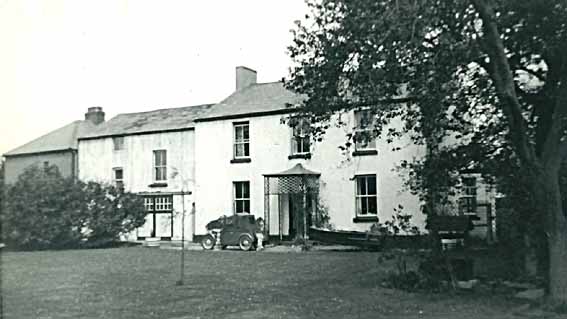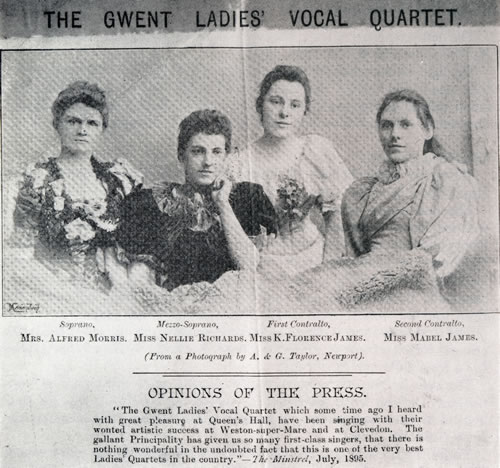Below are selections of text from the excellent little book The Living Village by SG Deane:
Page 16:
"Lulworth House School in the old village, Ultra Pontem, was run by Mrs Morris with her husband, Alfred, and her sister, Miss Cope. Sir Arthur Mackworth's children from The Priory were pupils, as was young Tom Parry, the son of Alderman Tom Parry.
Dorothy Taylor: I remember Freda Rickard, John Rennie and Les White being there with me. Les White was a terrible tease. Coming down the Black Ash path from Christchurch one day, he was teasing me and I took his cap and threw it over the hedge. I had to do a hundred lines for that.
There were about a dozen of us — quite a nice little crowd. Naturally we went to concerts, because Mrs Morris was a singer and on Ash Wednesday we had to walk up to Christchurch to go to church.
On open days some of the parents came to the school in a horse and carriage.
The school room was used for concerts and dances; it was used by the pupils but also became the Village Hall. It was a large hall with a stage, built in 1837. There was a long passage to it down the side of Lulworth House, where the boys and girls used to skylark about when no one was watching. Mrs Morris was not only a singer of some repute but was also organist at Christchurch. The First World War saw the school run down and it closed soon after.
Pages 81 – 84:
In 1837 Matthew Cope, a maltster, moved across the river from The Bull and built Lulworth House. The house and a malthouse were built in the garden of the White Lion Inn which was next door.
Matthew Cope made a will dated 16 November 1865 and he died in 1877. He left the malthouse and all his property to his son, William and his daughters Margaret and Martha. William also inherited 'the Trowbridge Estate at Rumney.' His other son, also named Matthew, seems to have been out of favour. He got only £100 and was forgiven his debts. His widow, Jane, was to have an annuity of £50, paid quarterly, but she was paid in arrears and had to wait three months for the first payment.
There is no further trace of William or Matthew, but the daughters lived in the house until 1919. Margaret married Alfred Morris and became a well known singer, organising concerts in many towns, as far away as Cheltenham, Poole and London. Her sister remained single and, together with Alfred Morris, they ran a 'Dame school', which opened about 1880.
Vera Lawrence: It was a big house but, to increase accommodation, they had attic rooms with dormer windows in the roof. While we lived there we had the windows taken out and the roof restored to its original state.
Instruction was not limited to educational subjects:
Dick Cook: Miss Cope and Mrs Morris ran the Sunday School and we also had a nice dancing class. Both teachers were very strict. The ladies had to be very proper - and the gentlemen - different from these days.
We had the 'old tyme' dances, the Veleta, Barn Dance and the Quadrille and Cotillion; then we came up to the Maxina. But most of all we used to enjoy the Lancers. Sometimes the boys would get a bit daring, and the girls weren't far behind. They'd swing the girls off their feet and as soon as that happened, 'Tap, tap, tap!' - and the music would stop.
'Gentlemen, please keep the ladies on their feet.'
Then we'd carry on again. It was real good fun.
We had about fifty, mostly from the old village but some from Penhow. I started when I was 13 and I went till I was 21; then I didn't dance again till I was over 70. After I married Amy I took it up again, and we're still going. I'm 80 this year.
The house was sold in 1919. The lych-gate at Christchurch is a memorial to Martha Cope who died in 1927, aged 77.

The next owner was John Arthur Morgan, believed to have been a butcher from one of the valleys. In 1925 it passed to John Burns, a full-time trade union official at Newport Docks. Then in 1934, it was bought by Henry Lawrence, whose father had built some of the houses in Broad Walk.
Charles Lawrence: When my father bought the house, Burns had been living in Weston-super-Mare for some time and it had been neglected.
The malthouse, which is now a garage, originally had three floors, malting floors, with only six feet between them. By that time one of the floors had been taken out and it was being used as a barn. Behind it, where the houses on Lulworth Road are now, was the schoolroom. It was a long building which had been used for dances but it, too, was in a state of disrepair. It had hardly any roof left and someone had taken away the floor and the wooden walls while the house had been empty.
The first time I saw it the grass was eighteen inches high and I fell into a cess pit which was only covered by a door. Fortunately it hadn't been used for a long time and it was dry,
The lawn in front of the house didn't belong to us. It was owned by Jesus College, Oxford. Until recently they owned the Toll House and the field behind it. They may still own it for all I know. It came to them originally from Goldcliff Priory.
Young Tom Parry was the agent when we bought it. His name wasn't Tom, but he was always called after his father. He called on us in 1957 and said the dining room was just as it was when he was there at school.
It's not been added to very much except to turn a single storey wash house into a two storey building.
There was well over an acre of garden and it was too big for them to look after, so Henry Lawrence arranged to build houses on part of it in Lulworth Road between 1935 and 1937. In 1956 Charles Lawrence bought the house from his mother and the family lived there until 1964. But with sixteen rooms it was too big, when his two children grew up, and he and his wife Vera moved to Anvil Cottage, in Ashwell."
Here is a section from chapter 4 of Caerleon Past and Present by Primrose Hockey:
"Lulworth House Preparatory School was opened in 1880 in Ultra Pontem. There are many men and women scattered throughout the world who had their preparatory schooling here. Mrs Alfred Morris and her husband came to Caerleon to live. She was listed as a vocalist of great charm and beauty and of Cheltenham and London. As has already been stated she brought a new cultural atmosphere into the town. She had a powerful soprano voice and was interested in music and soon had her Caerleon friends singing and attending concerts. Not content with this, she started a school at her home in Lulworth House. The school listed reading, writing, arithmetic, spelling, history, geography, French, scripture and music on the prospectus. Pupils who attended the school came from outlying districts. Those coming down the valley came by train. Many of them have told me how they hated going to school on May 29th that is, Oak Apple Day, for, to reach Lulworth House they had to come through the town and pass the Charity Schools. Here the boys were waiting and, if anyone had forgotten to wear an oak apple, they were chased by the boys and beaten with stinging nettles. In case anyone has forgotten, Oak Apple Day commemorated King Charles' escape after hiding in an oak tree. This school closed down in the 1920's."

Vera Lawrence: It was a big house but, to increase accommodation, they had attic rooms with dormer windows in the roof. While we lived there we had the windows taken out and the roof restored to its original state.
Below the Gwent Ladies' Vocal Quartet, Margaret Morris (nea Cope), soprano, left of picture:

from The Living Village
Useful Links on Caerleon Net:
Caerleon Books, including The Living Village and Caerleon Past and Present
1840 Tithe Map and Apportionment
1841 Census, 1881 Census & 1901 Census (1901 unfortunately doesn't yet include Ultra Pontem)
Burials at Castle Street Baptist Church (Includes members of the Cope Family)
Birth Marriage Burial records for Caerleon